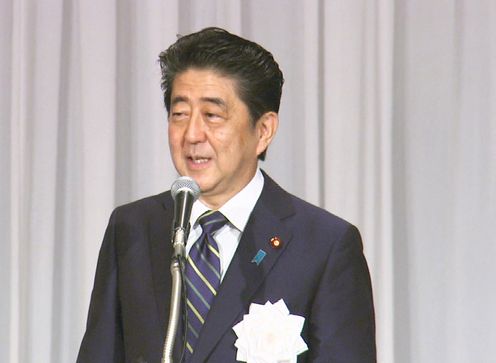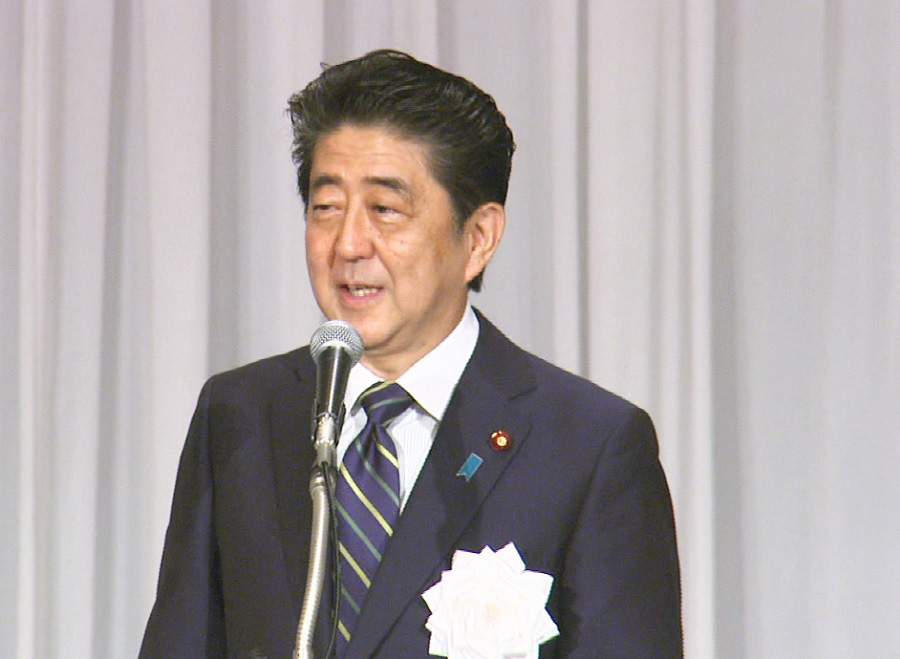Home > News > The Prime Minister in Action > June 2018 > General Meeting of the Japan Association of City Mayors
The Prime Minister in Action
General Meeting of the Japan Association of City Mayors
June 6, 2018
[Provisional Translation]
On June 6, 2018, Prime Minister Shinzo Abe attended the 88th General Meeting of the Japan Association of City Mayors and the Commemoration of its 120th Anniversary, held in Tokyo.
The Prime Minister said in his congratulatory address,
“I am truly delighted to see that the 88th General Meeting of the Japan Association of City Mayors is being held today in such magnificent fashion.
President Matsuura has just delivered his remarks, which was as bold as always. As the Prime Minister, I would like to express my sincere appreciation for all the hard work he has put in as President of the Japan Association of City Mayors. Thank you very much.
I would also like to extend my heartfelt respect to all the city mayors for your dedicated works every day at the front lines of local government to develop your communities and improve the welfare of your residents.
Japan will not have vitality unless its regions do. There is no future for Japan unless there is a future for its local districts. This is the basic philosophy of the Abe Cabinet. In the past five years, the Abe Cabinet has continued to take on the challenge of implementing the “three arrows” of Abenomics, the economic policy of the Abe Cabinet.
The economy has achieved record growth of more than 11%, while national and local tax revenue have increased by more than 24 trillion yen. The ratio of active job openings to applicants has exceed 1.0 for all 47 prefectures for the first time in history, and the employment rate of high school graduates this spring reached 98.1%, the highest level in 27 years. The ratio of active job openings to applicants for full-time employees has also exceeded 1.0, marking the acceleration in the transition toward greater full-time employment.
The numerous attractions of Japan’s local areas, which the members of local communities have strived to preserve and foster, including the abundant nature, unique history and culture, distinctive agricultural, forestry, and fishery produce, and other food products, have also become well-known overseas. Consequently, the number of foreign tourists to Japan has more than tripled, exceeding 28 million currently and registering a record high for five consecutive years.
The economic impact of this trend is beginning to spread steadily across all parts of Japan, and all parts of the world, through the various initiatives of local communities.
For instance, the multilingual guided tour for foreign visitors offered at Hirosaki Park in Hirosaki City has become quite popular. On this tour, tourists put on special glasses that allow them to enjoy the scenery at Hirosaki Castle that changes with the seasons, such as when the area is full of cherry blossoms or covered in snow.
At the Marugamemachi Shopping Street in Takamatsu City, the number of foreign tourists, which has increased as a result of events such as the Setouchi Triennale (ART SETOUCHI), can use smartphone apps to complete procedures for the exemption of consumption tax smoothly, allowing them to enjoy their shopping in a leisurely manner. Surprisingly, the number of foreign tourists staying overnight in Kagawa Prefecture has increased by as much as 10 times in the past five years. This number, which was 43,000 people in 2012, increased to 450,000 in 2017.
My hometown, Nagato City, has a small shrine called Motonosumi Inari Shrine, where a chain of red torii shrine gateways continue all the way toward the Sea of Japan. This was a shrine that used to see only several hundred visitors a year. However, it was featured on CNN and gained the reputation of being a highly “Instagrammable” location. As a result, 1 million people visited last year, and even the priest at the shrine was apparently surprised to find coins from 25 countries in the shrine’s offering box.
In short, we are seeing a gradual shift from shopping-oriented travel toward experience-based travel, which allows tourists to enjoy views or experiences that are unique to a particular place. I feel that this presents a great opportunity for the local districts.
The motivation and passion of local people, as well as the leadership demonstrated by all the city mayors, create attractive local districts. It is exactly the local economies that drive Japan’s growth.
While listening carefully to the voices of local communities, the Abe administration will continue to provide active support in the areas of information, human resources, and finance for the ambitious challenges undertaken by cities across Japan, so as to further accelerate regional vitalization and the development of local economies.
This year marks the 150th anniversary of the Meiji Restoration, and Japan is once again being confronted by a national crisis, namely the rapidly declining birthrate and aging population. To overcome this difficulty and further enrich the lives of the people, the Government is determined to take on the revolutions in productivity and human resources development much like two wheels of a cart.
I hope that all of you will continue to do your best to create a Japan where the residents of local districts, as well as their children, can entrust their dreams and future to their respective communities. I ask once again for your understanding and cooperation for the policies that are being promoted by the national government.
In closing, I would like to extend my best wishes for the continued development of the Japan Association of City Mayors, as well as the further success of everyone in attendance today. With that, I would like to end my speech for the 88th General Meeting of the Japan Association of City Mayors.”


